Monday, August 29, 2005
Saturday, August 20, 2005
The Valhalla for Fictional Figures
I searched for the preface of "The Case-book" the other day. "The Case-book" is the last but far from the best Sherlock Holmes series. Conan Doyle seemed so tired of writing a typical Holmes story then, he started experimenting: in “The Blanched Soldier”, Holmes himself told the story; “The Mazarin Stone” was told by the third person; there was no crime in “The Lion’s Mane”.... I don't know about other loyal readers of Conan Doyle, I didn't like it.
But the preface, which was actually placed in the end of the book in the Chinese edition, is one of my favorite essays. The reason is simple: in its first paragraph, Conan Doyle articulated something I always tried to say.
And below is what I got from “Camden House: The Complete Sherlock Holmes”, an excellent Holmes website.

PREFACE
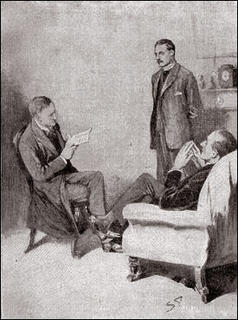 I FEAR that Mr. Sherlock Holmes may become like one of those popular tenors who, having outlived their time, are still tempted to make repeated farewell bows to their indulgent audiences. This must cease and he must go the way of all flesh, material or imaginary. One likes to think that there is some fantastic limbo for the children of imagination, some strange, impossible place where the beaux of Fielding may still make love to the belles of Richardson, where Scott’s heroes still may strut, Dickens’s delightful Cockneys still raise a laugh, and Thackeray’s worldlings continue to carry on their reprehensible careers. Perhaps in some humble corner of such a Valhalla, Sherlock and his Watson may for a time find a place, while some more astute sleuth with some even less astute comrade may fill the stage which they have vacated.
I FEAR that Mr. Sherlock Holmes may become like one of those popular tenors who, having outlived their time, are still tempted to make repeated farewell bows to their indulgent audiences. This must cease and he must go the way of all flesh, material or imaginary. One likes to think that there is some fantastic limbo for the children of imagination, some strange, impossible place where the beaux of Fielding may still make love to the belles of Richardson, where Scott’s heroes still may strut, Dickens’s delightful Cockneys still raise a laugh, and Thackeray’s worldlings continue to carry on their reprehensible careers. Perhaps in some humble corner of such a Valhalla, Sherlock and his Watson may for a time find a place, while some more astute sleuth with some even less astute comrade may fill the stage which they have vacated.
His career has been a long one–though it is possible to exaggerate it; decrepit gentlemen who approach me and declare that his adventures formed the reading of their boyhood do not meet the response from me which they seem to expect. One is not anxious to have one’s personal dates handled so unkindly. As a matter of cold fact, Holmes made his debut in A Study in Scarlet and in The Sign of Four, two small booklets which appeared between 1887 and 1889. It was in 1891 that ‘A Scandal in Bohemia,’ the first of the long series of short stories, appeared in The Strand Magazine. The public seemed appreciative and desirous of more, so that from that date, thirty-nine years ago, they have been produced in a broken series which now contains no fewer than fifty-six stories, republished in The Adventures, The Memoirs, The Return, and His Last Bow, and there remain these twelve published during the last few years which are here produced under the title of The Case-Book of Sherlock Holmes. He began his adventures in the very heart of the later Victorian era, carried it through the all-too-short reign of Edward, and has managed to hold his own little niche even in these feverish days. Thus it would be true to say that those who first read of him, as young men, have lived to see their own grown-up children following the same adventures in the same magazine. It is a striking example of the patience and loyalty of the British public.
I had fully determined at the conclusion of The Memoirs to bring Holmes to an end, as I felt that my literary energies should not be directed too much into one channel. That pale, clear-cut face and loose-limbed figure were taking up an undue share of my imagination. I did the deed, but fortunately no coroner had pronounced upon the remains, and so, after a long interval, it was not difficult for me to respond to the flattering demand and to explain my rash act away. I have never regretted it, for I have not in actual practice found that these lighter sketches have prevented me from exploring and finding my limitations in such varied branches of literature as history, poetry, historical novels, psychic research, and the drama. Had Holmes never existed I could not have done more, though he may perhaps have stood a little in the way of the recognition of my more serious literary work.
And so, reader, farewell to Sherlock Holmes! I thank you for your past constancy, and can but hope that some return has been made in the shape of that distraction from the worries of life and stimulating change of thought which can only be found in the fairy kingdom of romance.
ARTHUR CONAN DOYLE

序言
 我担心福尔摩斯先生也会变得象那些时髦的男高音歌手一样,在人老艺衰之后,还要频频地向宽厚的观众举行告别演出。是该收场了,不管是真人还是虚构的,福尔摩斯不可不退场。有人认为最好是能够有那么一个专门为虚构的人物而设的奇异的阴间——一个奇妙的、不可能存在的地方,在那里,菲尔丁的花花公子仍然可以向理查逊的美貌女郎求爱,司各特的英雄们仍然可以耀武扬威,狄更斯的欢乐的伦敦佬仍然在插科打诨,萨克雷的市侩们则照旧胡作非为。说不定就在这样一个神殿的某一偏僻的角落里,福尔摩斯和他的华生医生也许暂时可以找到一席之地,而把他们原先占据的舞台出让给某一个更精明的侦探和某一个更缺心眼儿的伙伴。
我担心福尔摩斯先生也会变得象那些时髦的男高音歌手一样,在人老艺衰之后,还要频频地向宽厚的观众举行告别演出。是该收场了,不管是真人还是虚构的,福尔摩斯不可不退场。有人认为最好是能够有那么一个专门为虚构的人物而设的奇异的阴间——一个奇妙的、不可能存在的地方,在那里,菲尔丁的花花公子仍然可以向理查逊的美貌女郎求爱,司各特的英雄们仍然可以耀武扬威,狄更斯的欢乐的伦敦佬仍然在插科打诨,萨克雷的市侩们则照旧胡作非为。说不定就在这样一个神殿的某一偏僻的角落里,福尔摩斯和他的华生医生也许暂时可以找到一席之地,而把他们原先占据的舞台出让给某一个更精明的侦探和某一个更缺心眼儿的伙伴。
福尔摩斯的事业已经有不少个年头儿了,这样说可能是夸张了一些。要是一些老先生们跑来对我说,他们儿童时代的读物就是福尔摩斯侦探案的话,那是不会得到我的恭维的。谁也不乐意把关乎个人年纪的事情这样地叫人任意编排。冷酷的事实是,福尔摩斯是在《血字的研究》和《四签名》里初露头角的,那是一八八七年和一八八九年之间出版的两本小书。此后问世的一系列短篇故事,头一篇叫做《波希米亚丑闻》,一八九一年发表在《海滨杂志》上。书出之后,似乎颇受欢迎,索求日增。于是自那以后,三十九年来断断续续所写的故事,迄今已不下于五十六七,编集为《冒险史》、《回忆录》、《归来记》和《最后致意》。其中近几年出版的最后这十二篇,现在收编为《新探案》。福尔摩斯开始他的探案生涯是在维多利亚朝晚期的中叶,中经短促的爱德华时期。即使在那个狂风暴雨的多事之秋,他也不曾中断他自己的事业。因此之故,要是我们说,当初阅读这些小说的青年现在又看到他们的成年子女在同一杂志上阅读同一侦探的故事,也不为过。于此也就可见不列颠公众的耐心与忠实之一斑了。
在写完《回忆录》之后我下定决心结束福尔摩斯的生命,因为我感到不能使我的文学生涯完全纳入一条单轨。这位面颊苍白严峻、四肢懒散的人物,把我的想象力占去了不应有的比例。于是我就这么结果了他。幸亏没有验尸官来检验他的尸体,所以,在事隔颇久以后,我还能不太费力地响应读者的要求,把我当初的鲁莽行为一推了事。对于重修旧业我倒并不后悔,因为在实际上我并没有发现写这些轻松故事妨碍了我钻研历史、诗歌、历史小说、心理学以及戏剧等等多样的文学形式,并在这些钻研之中认识到我的才力之有限。要是福尔摩斯压根儿就没存在过的话,我也未必能有更大的成就,只不过他的存在可能有点妨碍人家看到我其它严肃的文学著作而已。
所以,读者们,还是让福尔摩斯与诸位告别吧!我对诸君以往给我的信任无限感激,在此谨希望我赠给的消遣良法可以报答诸君,因为小说幻境乃是避世消愁的唯一途径。
阿瑟•柯南•道尔谨启
But the preface, which was actually placed in the end of the book in the Chinese edition, is one of my favorite essays. The reason is simple: in its first paragraph, Conan Doyle articulated something I always tried to say.
And below is what I got from “Camden House: The Complete Sherlock Holmes”, an excellent Holmes website.

 I FEAR that Mr. Sherlock Holmes may become like one of those popular tenors who, having outlived their time, are still tempted to make repeated farewell bows to their indulgent audiences. This must cease and he must go the way of all flesh, material or imaginary. One likes to think that there is some fantastic limbo for the children of imagination, some strange, impossible place where the beaux of Fielding may still make love to the belles of Richardson, where Scott’s heroes still may strut, Dickens’s delightful Cockneys still raise a laugh, and Thackeray’s worldlings continue to carry on their reprehensible careers. Perhaps in some humble corner of such a Valhalla, Sherlock and his Watson may for a time find a place, while some more astute sleuth with some even less astute comrade may fill the stage which they have vacated.
I FEAR that Mr. Sherlock Holmes may become like one of those popular tenors who, having outlived their time, are still tempted to make repeated farewell bows to their indulgent audiences. This must cease and he must go the way of all flesh, material or imaginary. One likes to think that there is some fantastic limbo for the children of imagination, some strange, impossible place where the beaux of Fielding may still make love to the belles of Richardson, where Scott’s heroes still may strut, Dickens’s delightful Cockneys still raise a laugh, and Thackeray’s worldlings continue to carry on their reprehensible careers. Perhaps in some humble corner of such a Valhalla, Sherlock and his Watson may for a time find a place, while some more astute sleuth with some even less astute comrade may fill the stage which they have vacated.His career has been a long one–though it is possible to exaggerate it; decrepit gentlemen who approach me and declare that his adventures formed the reading of their boyhood do not meet the response from me which they seem to expect. One is not anxious to have one’s personal dates handled so unkindly. As a matter of cold fact, Holmes made his debut in A Study in Scarlet and in The Sign of Four, two small booklets which appeared between 1887 and 1889. It was in 1891 that ‘A Scandal in Bohemia,’ the first of the long series of short stories, appeared in The Strand Magazine. The public seemed appreciative and desirous of more, so that from that date, thirty-nine years ago, they have been produced in a broken series which now contains no fewer than fifty-six stories, republished in The Adventures, The Memoirs, The Return, and His Last Bow, and there remain these twelve published during the last few years which are here produced under the title of The Case-Book of Sherlock Holmes. He began his adventures in the very heart of the later Victorian era, carried it through the all-too-short reign of Edward, and has managed to hold his own little niche even in these feverish days. Thus it would be true to say that those who first read of him, as young men, have lived to see their own grown-up children following the same adventures in the same magazine. It is a striking example of the patience and loyalty of the British public.
I had fully determined at the conclusion of The Memoirs to bring Holmes to an end, as I felt that my literary energies should not be directed too much into one channel. That pale, clear-cut face and loose-limbed figure were taking up an undue share of my imagination. I did the deed, but fortunately no coroner had pronounced upon the remains, and so, after a long interval, it was not difficult for me to respond to the flattering demand and to explain my rash act away. I have never regretted it, for I have not in actual practice found that these lighter sketches have prevented me from exploring and finding my limitations in such varied branches of literature as history, poetry, historical novels, psychic research, and the drama. Had Holmes never existed I could not have done more, though he may perhaps have stood a little in the way of the recognition of my more serious literary work.
And so, reader, farewell to Sherlock Holmes! I thank you for your past constancy, and can but hope that some return has been made in the shape of that distraction from the worries of life and stimulating change of thought which can only be found in the fairy kingdom of romance.
ARTHUR CONAN DOYLE

 我担心福尔摩斯先生也会变得象那些时髦的男高音歌手一样,在人老艺衰之后,还要频频地向宽厚的观众举行告别演出。是该收场了,不管是真人还是虚构的,福尔摩斯不可不退场。有人认为最好是能够有那么一个专门为虚构的人物而设的奇异的阴间——一个奇妙的、不可能存在的地方,在那里,菲尔丁的花花公子仍然可以向理查逊的美貌女郎求爱,司各特的英雄们仍然可以耀武扬威,狄更斯的欢乐的伦敦佬仍然在插科打诨,萨克雷的市侩们则照旧胡作非为。说不定就在这样一个神殿的某一偏僻的角落里,福尔摩斯和他的华生医生也许暂时可以找到一席之地,而把他们原先占据的舞台出让给某一个更精明的侦探和某一个更缺心眼儿的伙伴。
我担心福尔摩斯先生也会变得象那些时髦的男高音歌手一样,在人老艺衰之后,还要频频地向宽厚的观众举行告别演出。是该收场了,不管是真人还是虚构的,福尔摩斯不可不退场。有人认为最好是能够有那么一个专门为虚构的人物而设的奇异的阴间——一个奇妙的、不可能存在的地方,在那里,菲尔丁的花花公子仍然可以向理查逊的美貌女郎求爱,司各特的英雄们仍然可以耀武扬威,狄更斯的欢乐的伦敦佬仍然在插科打诨,萨克雷的市侩们则照旧胡作非为。说不定就在这样一个神殿的某一偏僻的角落里,福尔摩斯和他的华生医生也许暂时可以找到一席之地,而把他们原先占据的舞台出让给某一个更精明的侦探和某一个更缺心眼儿的伙伴。福尔摩斯的事业已经有不少个年头儿了,这样说可能是夸张了一些。要是一些老先生们跑来对我说,他们儿童时代的读物就是福尔摩斯侦探案的话,那是不会得到我的恭维的。谁也不乐意把关乎个人年纪的事情这样地叫人任意编排。冷酷的事实是,福尔摩斯是在《血字的研究》和《四签名》里初露头角的,那是一八八七年和一八八九年之间出版的两本小书。此后问世的一系列短篇故事,头一篇叫做《波希米亚丑闻》,一八九一年发表在《海滨杂志》上。书出之后,似乎颇受欢迎,索求日增。于是自那以后,三十九年来断断续续所写的故事,迄今已不下于五十六七,编集为《冒险史》、《回忆录》、《归来记》和《最后致意》。其中近几年出版的最后这十二篇,现在收编为《新探案》。福尔摩斯开始他的探案生涯是在维多利亚朝晚期的中叶,中经短促的爱德华时期。即使在那个狂风暴雨的多事之秋,他也不曾中断他自己的事业。因此之故,要是我们说,当初阅读这些小说的青年现在又看到他们的成年子女在同一杂志上阅读同一侦探的故事,也不为过。于此也就可见不列颠公众的耐心与忠实之一斑了。
在写完《回忆录》之后我下定决心结束福尔摩斯的生命,因为我感到不能使我的文学生涯完全纳入一条单轨。这位面颊苍白严峻、四肢懒散的人物,把我的想象力占去了不应有的比例。于是我就这么结果了他。幸亏没有验尸官来检验他的尸体,所以,在事隔颇久以后,我还能不太费力地响应读者的要求,把我当初的鲁莽行为一推了事。对于重修旧业我倒并不后悔,因为在实际上我并没有发现写这些轻松故事妨碍了我钻研历史、诗歌、历史小说、心理学以及戏剧等等多样的文学形式,并在这些钻研之中认识到我的才力之有限。要是福尔摩斯压根儿就没存在过的话,我也未必能有更大的成就,只不过他的存在可能有点妨碍人家看到我其它严肃的文学著作而已。
所以,读者们,还是让福尔摩斯与诸位告别吧!我对诸君以往给我的信任无限感激,在此谨希望我赠给的消遣良法可以报答诸君,因为小说幻境乃是避世消愁的唯一途径。
阿瑟•柯南•道尔谨启
Labels:
读书
Thursday, August 18, 2005
小孤山 - 彭郎屿 - 大孤山
朋友送我一本画册《千里江城:二十世纪初长江流域景观图集》。前言里写到“二十世纪初,… 一个在中国生活了二十年的钟情于长江文化的日本人山根倬三,用相机记录了那个时代,他后来从千余张照片中整理出一百五十余张,加上搜集来的稀有图片,汇集成《长江大观》,那是用珂罗版印制,厚重而精致的游记式图集,出版于1916年” 。这本《千里江城》就是基于此书整理编缉的。
书里有大量有趣的照片,里面的很多景象现在都不可得了,比如西湖雷峰塔,南京秦淮贡院,武汉黄鹤楼等等。第78页是安徽宿松彭泽的小孤山(图1左),小孤山的名字中学时学到过。是在苏轼的《李思训画长江绝岛图》:
山苍苍,水茫茫,大孤小孤江中央。崖崩路绝猿鸟去,惟有乔木参天长,客舟何处来?卓歌中流声抑扬。沙平风软望不到,孤山久与船低昂。峨峨两烟鬟, 晓镜开新妆,舟中贾客莫漫狂,小姑前年嫁彭郎。(卓应为左木右卓)
 以前从未见过它的照片,今日看来果然可以称得上是风姿绰约。又有少许建筑,点缀得小山如盆景一样玲珑可爱。又上网找到了几幅小孤山的近照,有一张居然是差不多和山根倬三同一角度拍的(图1中),背景处的彭郎屿位置也相仿。可惜现在山上建筑有点太多了。不禁想到十年后又会是个什么样子,希望至少不会象我想象得那样吧(图1右)。
以前从未见过它的照片,今日看来果然可以称得上是风姿绰约。又有少许建筑,点缀得小山如盆景一样玲珑可爱。又上网找到了几幅小孤山的近照,有一张居然是差不多和山根倬三同一角度拍的(图1中),背景处的彭郎屿位置也相仿。可惜现在山上建筑有点太多了。不禁想到十年后又会是个什么样子,希望至少不会象我想象得那样吧(图1右)。
看地图小孤山应该离天柱山不远。天柱山我十多年前去过,风景很好。记得上山时遇大雨,又饿又累,半山处在农家吃了碗这辈子吃过的最香的素面条。下山时天大晴,满山瀑布,从山脚看去就象个大屏风。不知什么时候会再去看看,下次争取看一下小孤山。这地图不怎么清楚,小孤山的位置看不出,彭郎屿也没标上。幸好我们还有 Google Earth,打开程序,转动地球,找到中国,然后长江,鄱阳湖往北,对照地图几分种后就到了小孤山上空。下面第一张图是网上找来的地图。第二张图是相应的卫星照片。然后往下分辨率依此提高。最后一张上江北的小圆点就是小孤山了,江对面当为彭郎屿。
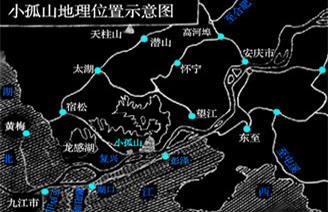
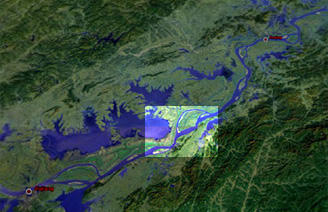
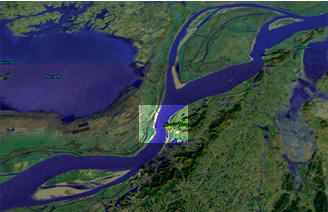
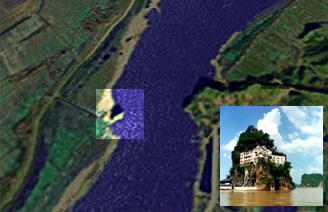 从照片上看小孤山已与岸相联,不再是江心孤岛了。 岛左边隐隐有条细直线,应该是条上岛的公路,那么我画的小孤山未来图也并非全无根据了。长江到此稍稍变窄,小孤山和彭郎屿恰如咽喉。
从照片上看小孤山已与岸相联,不再是江心孤岛了。 岛左边隐隐有条细直线,应该是条上岛的公路,那么我画的小孤山未来图也并非全无根据了。长江到此稍稍变窄,小孤山和彭郎屿恰如咽喉。
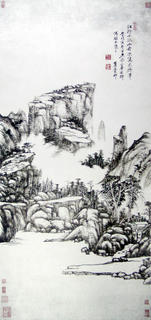
李思训的《长江绝岛图》没找到。这幅是王原祁的小孤山图轴,作者自题:“江行小孤山舟次写大痴笔,时戊寅冬日。庚辰小春京邸偶检出题之,麓台祁。”对照照片,画得未免有点太不像了。有人说四王泥古不化,也不是全无道理吧。
大孤山在小孤山南,鄱阳湖口,与小孤山遥遥相望(见下图)。山型一头高一头低,远望似一只巨鞋浮于水上,又名“鞋山”。岛右面细线应该是座大桥吧。查大孤山大半结果都是关于东北的一座同名小山,查鞋山的话第一条新闻如下:
书里有大量有趣的照片,里面的很多景象现在都不可得了,比如西湖雷峰塔,南京秦淮贡院,武汉黄鹤楼等等。第78页是安徽宿松彭泽的小孤山(图1左),小孤山的名字中学时学到过。是在苏轼的《李思训画长江绝岛图》:
山苍苍,水茫茫,大孤小孤江中央。崖崩路绝猿鸟去,惟有乔木参天长,客舟何处来?卓歌中流声抑扬。沙平风软望不到,孤山久与船低昂。峨峨两烟鬟, 晓镜开新妆,舟中贾客莫漫狂,小姑前年嫁彭郎。(卓应为左木右卓)
 以前从未见过它的照片,今日看来果然可以称得上是风姿绰约。又有少许建筑,点缀得小山如盆景一样玲珑可爱。又上网找到了几幅小孤山的近照,有一张居然是差不多和山根倬三同一角度拍的(图1中),背景处的彭郎屿位置也相仿。可惜现在山上建筑有点太多了。不禁想到十年后又会是个什么样子,希望至少不会象我想象得那样吧(图1右)。
以前从未见过它的照片,今日看来果然可以称得上是风姿绰约。又有少许建筑,点缀得小山如盆景一样玲珑可爱。又上网找到了几幅小孤山的近照,有一张居然是差不多和山根倬三同一角度拍的(图1中),背景处的彭郎屿位置也相仿。可惜现在山上建筑有点太多了。不禁想到十年后又会是个什么样子,希望至少不会象我想象得那样吧(图1右)。看地图小孤山应该离天柱山不远。天柱山我十多年前去过,风景很好。记得上山时遇大雨,又饿又累,半山处在农家吃了碗这辈子吃过的最香的素面条。下山时天大晴,满山瀑布,从山脚看去就象个大屏风。不知什么时候会再去看看,下次争取看一下小孤山。这地图不怎么清楚,小孤山的位置看不出,彭郎屿也没标上。幸好我们还有 Google Earth,打开程序,转动地球,找到中国,然后长江,鄱阳湖往北,对照地图几分种后就到了小孤山上空。下面第一张图是网上找来的地图。第二张图是相应的卫星照片。然后往下分辨率依此提高。最后一张上江北的小圆点就是小孤山了,江对面当为彭郎屿。



 从照片上看小孤山已与岸相联,不再是江心孤岛了。 岛左边隐隐有条细直线,应该是条上岛的公路,那么我画的小孤山未来图也并非全无根据了。长江到此稍稍变窄,小孤山和彭郎屿恰如咽喉。
从照片上看小孤山已与岸相联,不再是江心孤岛了。 岛左边隐隐有条细直线,应该是条上岛的公路,那么我画的小孤山未来图也并非全无根据了。长江到此稍稍变窄,小孤山和彭郎屿恰如咽喉。
李思训的《长江绝岛图》没找到。这幅是王原祁的小孤山图轴,作者自题:“江行小孤山舟次写大痴笔,时戊寅冬日。庚辰小春京邸偶检出题之,麓台祁。”对照照片,画得未免有点太不像了。有人说四王泥古不化,也不是全无道理吧。
大孤山在小孤山南,鄱阳湖口,与小孤山遥遥相望(见下图)。山型一头高一头低,远望似一只巨鞋浮于水上,又名“鞋山”。岛右面细线应该是座大桥吧。查大孤山大半结果都是关于东北的一座同名小山,查鞋山的话第一条新闻如下:
新华网南昌2月28日电:中国第一个水上古战场兵器陈列馆,近日在江西鄱阳湖鞋山建成,共陈列了500多件在历次水战中失落于湖中的各种兵器。 鞋山位于鄱阳湖湖口县水域,距长江9公里,号称“江湖锁钥”,历来是兵家必争之地,这里曾发生大小战争近百次。从周瑜鄱湖操练水军、朱元璋与陈友谅的鄱湖之战,到太平天国时期的石达开与曾国藩的湘军水师大战等都在该水域展开,大量兵器散落于湖底。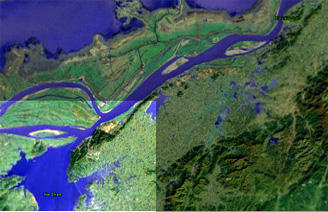
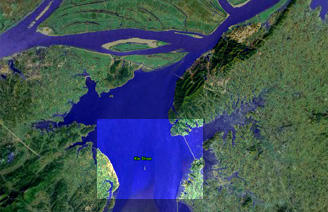
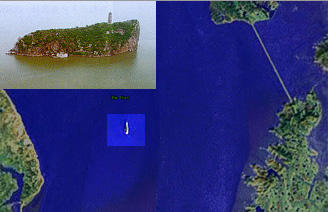
Labels:
读书
Wednesday, August 17, 2005
“天上行舟”与“车行树腹”续
我买的《吴友如画宝》是喀什维吾尔出版社发行的。正版盗版不详,反正印刷质量不敢恭维。画勉强可看,字就困难了。非得仔细揣摩才可以读顺读懂。“天上行舟”其实也提到“西人于是就将气球之法扩而充之,造成气船”。那么是吴友如不太了解“气球之法”了。查了一下,世界上第一艘商用飞艇是 Zeppelin 公司1910年造的 Deutschland 号,吴友如不可能见到其照片。另外 Zeppelin 是个德国公司,画中所说的“英美人”看来没有成功。“车行树腹”指明是旧金山,我猜就是在 Yosemite 的红木国家公园吧。我记得见过一张有车穿过的老照片,不过没有在网上找到。贴上几张有关的照片,添些余兴。
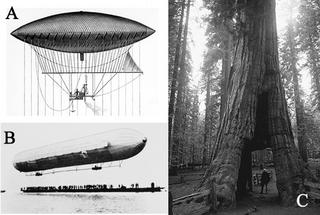 A: the first steam balloon was constructed by Frenchman Henri Giffard in 1852. B: the first ascent of the world's first untethered rogid airship, the LZ-1, on July 2, 1900. C: the sequoia with a hole.
A: the first steam balloon was constructed by Frenchman Henri Giffard in 1852. B: the first ascent of the world's first untethered rogid airship, the LZ-1, on July 2, 1900. C: the sequoia with a hole.
 A: the first steam balloon was constructed by Frenchman Henri Giffard in 1852. B: the first ascent of the world's first untethered rogid airship, the LZ-1, on July 2, 1900. C: the sequoia with a hole.
A: the first steam balloon was constructed by Frenchman Henri Giffard in 1852. B: the first ascent of the world's first untethered rogid airship, the LZ-1, on July 2, 1900. C: the sequoia with a hole.
Labels:
读书
Sunday, August 14, 2005
《吴友如画宝》
 鲁迅在《上海文艺之一瞥》里提到:
鲁迅在《上海文艺之一瞥》里提到:在这之前,早已出现了一种画报,名目就叫《点石斋画报》,是吴友如主笔的,神仙人物,内外新闻,无所不画,但对于外国事情,他很不明白,例如画战舰罢,是一只商船,而舱面上摆着野战炮;画决斗则两个穿礼服的军人在客厅里拔长刀相击,至于将花瓶也打落跌碎。然而他画“老鸨虐妓”,“流氓拆梢”之类,却实在画得很好的,我想,这是因为他看得太多了的缘故;就是在现在,我们在上海也常常看到和他所画一般的脸孔。这画报的势力,当时是很大的,流行各省,算是要知道“时务”——这名称在那时就如现在之所谓“新学”——的人们的耳目。前几年又翻印了,叫作《吴友如墨宝》,...

一直想找来鲁迅提及的这几幅画看看。今年回国去书店,《点石斋画报》没见到,《吴友如画宝》倒买到了。看介绍应该就是鲁迅所谓的《吴友如墨宝》。来回翻了几遍,居然一幅都没找到。《海国丛谈图》收海外风俗画一百幅,有轮船的有几幅,但未见战舰和决斗。《古今丛谈图》和《风俗志图说》收中国风俗画四百幅,也未见“老鸨虐妓”或“流氓拆梢” - 看来恰巧都没收入进来。不过鲁迅说吴友如“对于外国事情,他很不明白”,大约是对的:“天上行舟”里的飞舟真的画成了船型,我猜那舟多半该是飞艇吧。“车行树腹”里的车也应该不是火车,红木画得也不甚对。不过吴友如的风俗画“采用西洋透视方法,线条以单线勾勒,画面丰富紧凑”,看起来还是很有趣味的。

附:
吴友如(?~1893)又名嘉猷。江苏元和(今吴县)人,幼时家贫,父母早亡,寄食于伯父家,在苏州阊门城内西街云空阁裱画店当学徒。喜爱绘画。得画家张志瀛指导。在绘画上吸取清人钱杜、改琦、任熊的画法,工于人物肖像。曾应征至北京为宫廷作画,画过《中兴功臣图》。返上海后入点石斋书局,为主要画师。1884年申报馆创办《点石斋画报》,由吴友如主绘。1890年,吴友如另创《飞影阁画报》,内容格式和《点石斋画报》相同,其中图画多出吴友如之手;又另创《飞影阁画册》,多画历史人物、翎毛花卉。还以飞影阁名义出版彩色年画。他的传世作品有1880年画的《豫园宴集图》,现藏南京博物院,1883年画的《五子图》,现藏中国美术馆。
Labels:
读书
Saturday, August 13, 2005
About Saul Steinberg
I have a used copy of the first edition of "passport". The previous owner seemed to be a big fan of Saul Steinberg: between the book cover and the title page, I found a carefully folded 1999 New York Times obituary of Steinberg titled "Saul Steinberg, Who Transformed Epic Doodles Into Fine Art, Is Dead at 84". Thank this anonymous collector, I read this interesting article, which is no longer free on the New York Times website, and learned the following amusing facts of Saul Steinberg:

But Mr. Steinberg was known to most of people, as he lamented late in life, as “the man who did that poster”. That poster, one of the most famous American drawings, portrays a New Yorker’s shortsighted view of the rest of the world, in which everything in the landscape recedes according to its cultural distance from Manhattan. … which first appeared on The New Yorker cover of March 29, 1976. It was subsequently copied in knockoffs made for London, Paris, Rome, Venice, Kansa City, Durango, wherever. “I could have retired on this painting,” if royalties had been paid, he once mused. But they weren’t, and he didn’t.
... 1943, was momentous for Mr. Steinberg. … and on the same day that he became United States citizen he was given an ensign’s commission in the Navy. He was assigned to teach Chinese guerrillas how to blow up bridges, and for a year flew the mountainous route known as the Hump from China to India, making sure that the explosives reached their destinations (Is it why there is China in that famous drawing? - Albatross).
He was fond of diners, motels, kidney-shaped swimming pools and highways, and he thought the country was best seen from the height of a bus window. He was a European sophisticate posing as a regular American guy. Roger Angell of The New Yorker recalled that Mr. Steinberg became such a baseball fan that “he acquired a Milwaukee Braves uniform that he used to put on to watch the games on television”.
“Steinberg kept away from cartoonists,” Mr. Koren recalled. “Steinberg was not a warm man. He was chilly and Olympian with a somewhat hauteur tone.” Once, Mr. Koren said, the two were together at a dinner party. “I got somewhat in my cups, cheery, and I said, ‘you know, Saul, you’ve been a profound influence on me.’ He looked at me chillily and said, ‘I would be surprised if I wasn’t.’”

But Mr. Steinberg was known to most of people, as he lamented late in life, as “the man who did that poster”. That poster, one of the most famous American drawings, portrays a New Yorker’s shortsighted view of the rest of the world, in which everything in the landscape recedes according to its cultural distance from Manhattan. … which first appeared on The New Yorker cover of March 29, 1976. It was subsequently copied in knockoffs made for London, Paris, Rome, Venice, Kansa City, Durango, wherever. “I could have retired on this painting,” if royalties had been paid, he once mused. But they weren’t, and he didn’t.
... 1943, was momentous for Mr. Steinberg. … and on the same day that he became United States citizen he was given an ensign’s commission in the Navy. He was assigned to teach Chinese guerrillas how to blow up bridges, and for a year flew the mountainous route known as the Hump from China to India, making sure that the explosives reached their destinations (Is it why there is China in that famous drawing? - Albatross).
He was fond of diners, motels, kidney-shaped swimming pools and highways, and he thought the country was best seen from the height of a bus window. He was a European sophisticate posing as a regular American guy. Roger Angell of The New Yorker recalled that Mr. Steinberg became such a baseball fan that “he acquired a Milwaukee Braves uniform that he used to put on to watch the games on television”.
“Steinberg kept away from cartoonists,” Mr. Koren recalled. “Steinberg was not a warm man. He was chilly and Olympian with a somewhat hauteur tone.” Once, Mr. Koren said, the two were together at a dinner party. “I got somewhat in my cups, cheery, and I said, ‘you know, Saul, you’ve been a profound influence on me.’ He looked at me chillily and said, ‘I would be surprised if I wasn’t.’”
Labels:
读书
Friday, August 05, 2005
龚贤的几个册页
这是两年前在纽约大都会博物馆看到的龚贤的几个册页。非常喜欢,拍了几张照片,可惜光线太弱了。后面的文章是在网上找到的,说的主要是其大幅作品。这些册页由繁入简,反朴归真,又是另一种风格了。


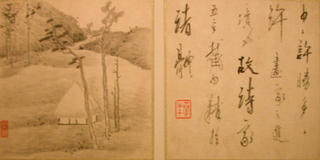
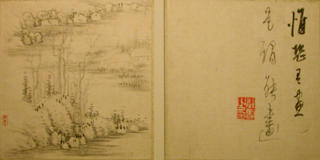




龚贤(1618-1689)清代著名画家。字半千,又字野遗、岂贤,号半亩,又号柴丈人。江苏昆山人。后迁居南京。“金陵八家”之一。出身贫苦,性孤僻,具有正直不阿的人格,晚年以卖画为生。在诗、书、画上都有一定的成就。在南京的“复社”中是知名的人物。明亡后定居在南京清凉山,修筑半亩园。善画山水,初从北宋入手。主要师法源,二米(米芾,米友仁父子),主张革新,强调以自然为本,抒发自己的情感,自成一家风格。他把山水画艺术的表现技巧概括为四个根本方面:笔法、墨气、丘壑、气韵。并以创造丘壑为重。他的用笔是“秃而老“,在描写涧壑溪桥、茅亭古树时,不着晕染而气势自然,苍劲深厚。画山石皴擦多至十余次,而常以浓淡不同的厚重颜色,相当真实地刻划出湿润多雨的山林景色,具有一种厚重浓淡、沉雄郁茂的独特风格。末年竟为南京权贵欺凌致病而死。代表作有:《深山飞瀑图》、《急峡风帆图》、《木叶丹黄图》、《重山烟树图》、《溪山人家图》、《云林西园图》等,其著作为:《画诀》、《香草堂集》、《柴丈人画稿》等。
Labels:
读书
Subscribe to:
Posts (Atom)


